Search
Search for "click":
(Click here to search this entire website for "click" with Google.)
 |

|
|
Perfect control over RBG LEDs
LED Driver 3 click is an RGB LED driver, capable of driving RGB LEDs with up to 30mA per segment, via the digital I2C interface. It comes with an RGB LED onboard, and is capable of displaying a palette of 32768 colors. It features an integrated circuit with three independent LED driver sections and a programmable gradual dimming control, which gives a smooth dimming effect. Heat dissipation is taken to the minimum, due to a fact that the used driver IC works with up to 94% efficiency. |
|
|
|
 |
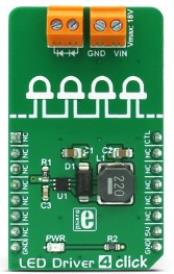
|
|
LED Driver 4 click is a form of a high-efficiency boost converter that is ideally suited for driving an array of white LEDs. The driver has the ability to dim the connected LED array, without producing any noise on the output. The Click board™ is capable of driving a LED array with up to 26V, providing a constant current to the LED segments. The LED segments are connected in series between the output terminals, which results in an even current distribution, thus providing a uniform brightness of each LED. A built-in soft-start function prevents large inrush current. Output open LED circuit, thermal, and undervoltage protection, provide a reliable operation. |
|
|
|
 |
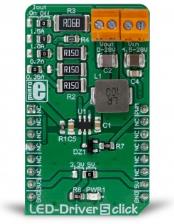
|
|
LED Driver 5 click is a Click board™ capable of driving an array of high-power LEDs with constant current, up to 1.5A. This Click board™ features the TPS54200, a highly integrated LED driver IC, with many useful features. It consists of a synchronous, fixed-frequency buck converter which operates at 600kHz, providing an excellent size/efficiency ratio. LED Driver 5 click can use both analog and PWM control signal for dimming the connected LED array.
It comes in the package which also includes the mikroSDK™ software and a library with all the functions. The Click board™ comes as a fully tested and approved prototype, making it a reliable device ready to use on the development board.
|
|
|
|
 |
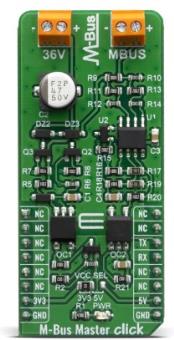
|
|
The M-Bus Master is a Click board™ is complete solution for a master node in M-Bus networks. The M-Bus ("Meter-Bus") is a new European standard for remote reading of heat meters and it is also usable for all other types of consumption meters as well as for various sensors and actuators. Given all the features these elements offer, the M-Bus Master click can be used for low cost applications, and low voltage, MCU based, single supply applications.
The M-Bus Master click is supported by a mikroSDK compliant library, which includes functions that simplify software development. This Click board™ comes as a fully tested product, ready to be used on a system equipped with the mikroBUS™ socket.
|
|
|
|
 |
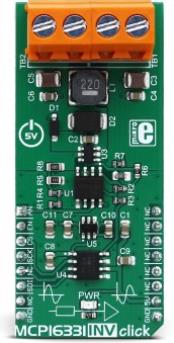
|
|
MCP16331 INV click works as a buck-boost voltage regulator, a switching regulator topology that combines principles of the buck conversion (step-down) and the boost conversion (step-up). A buck converter outputs voltage that is smaller than the input voltage (steps down the input voltage). A boost converter outputs voltage that is greater than the input voltage (steps up the input voltage). By combining these two topologies, MCP16331 INV click is able to output a regulated DC voltage, which can be set in the code, for input voltage both greater and less than the output voltage.
A major difference between the MCP16331 INV click and another click with the same name - MCP16331 click, is that this click works in an inverting configuration, providing an output voltage which is negative in respect to the GND level. Negative voltage is often used in symmetrical power supply configurations - for powering up operational amplifiers and similar devices that require such type of power supply. This feature, as well as the excellent power switching efficiency, overtemperature protection, and a clean regulated voltage output makes this device an ideal solution for powering up any application that demands a negative voltage power supply. |
|
|
|
 |

|
|
MOTION click is a motion detector sensitive only to live bodies. It carries PIR500B, a pyroelectric sensor which generates a voltage when exposed to infrared light. The signal is processed by a BIS0001 PIR sensor controller which sends an interrupt to the MCU through the mikroBUS INT (out) line. An onboard potentiometer lets you adjust the detecting range of the sensor (up to 4 meters). MOTION click also has a night only mode—resoldering a zero-ohm jumper activates the onboard photo resistor which acts as a light-sensitive switch. You can also switch the sensor ON and OFF by sending a signal from the MCU through the mikroBUS RST pin. The board uses a 3.3V power supply only. |
|
|
|
 |

|
|
Nano Power 2 click is a very low power voltage comparator, aimed at portable and battery-powered applications. It allows detecting a difference of two voltage potentials, applied on two input pins. The device can detect differences very precisely, avoiding oscillations that can occur when both input voltages are equal by employing an internal hysteresis. Nano Power 2 click offers a choice to select one of the input voltages from the internal fixed reference of 1.2V, or by setting both input voltages by the onboard potentiometers. |
|
|
|
 |

|
|
Optical sensor/encoder click
Opto Encoder click is a linear incremental optical sensor/encoder click, which can be used for the movement or rotation encoding. Encoders of this type are widely used for many applications which involve precise detection of the position, speed, or rotational angle of an object. Rotary encoders are often used for various types of controllers on many different devices. Whether it be a rotary encoded knob controller or a rotation encoder on a motor shaft, the principle is the same - it includes an optical sensor, just like the one found on Opto Encoder click. |
|
|
|
 |
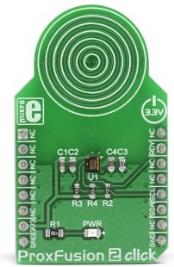
|
|
ProxFusion® 2 Click is an ambient lighting, capacitive, Hall-effect, and inductive sensing Click board™ which features a single multifunctional sensor IC. The IQS621 IC from ProxFusion® sensor series offers several ProxSense® engine capabilities, with additional sensor types. Thanks to its high level of integration, this sensor requires a low number of external components, which combined with its very low power consumption, makes it a perfect solution for IoT applications. Such applications can also benefit from a variety of sensors on the same die, allowing more complex devices to be designed, with no additional costs.
ProxFusion® 2 Click is supported by a mikroSDK compliant library, which includes functions that simplify software development. This Click board™ comes as a fully tested product, ready to be used on a system equipped with the mikroBUS™ socket.
|
|
|
|
 |

|
|
Proximity 10 Click is a versatile proximity detection device on a Click board™. It can detect a foreign object distanced up to 200cm. The Click board™ features a detection sensor IC that can trigger a programmable-event interrupts, which makes this Click board™ capable of detecting even simple gesture movements. The advanced onboard IC sensor features LED driver section, a light sensor with the integrated analog front end (AFE), 16 bit analog to digital converter (ADC), and digital engine for processing and aggregation of the measurement result, which simplifies the firmware development. The ambient light cancellation includes both digital and optical filtering, resulting in increased detection reliability.
Proximity 10 click is supported by a mikroSDK compliant library, which includes functions that simplify software development. This Click board™ comes as a fully tested product, ready to be used on a system equipped with the mikroBUS™ socket.
|
|
|
|
 |
|
<< First
< Previous
Next >
|
|

